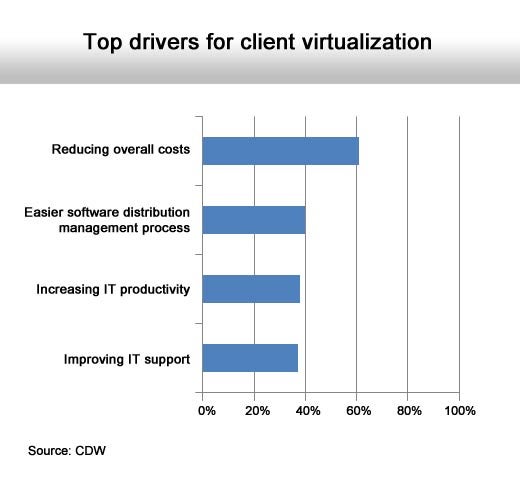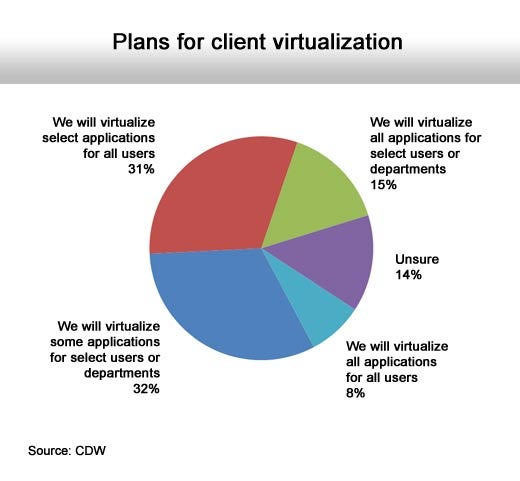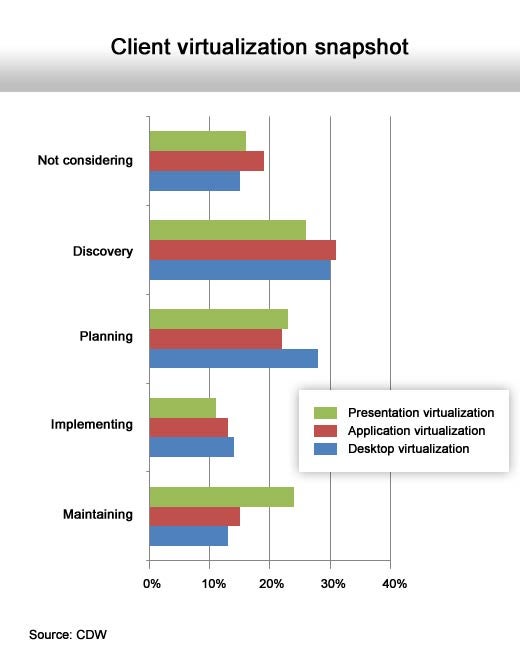IT professionals are the ultimate multitaskers – balancing data center priorities, equipment issues and end user needs and making sure that everything and everyone is perfectly synced and functioning smoothly. Let’s not forget to mention that every day we find new “must have” tools and applications for IT to support.
To help ease the potential for to-do list overload, organizations are turning to client virtualization – and its subsets presentation, application, and desktop virtualization – which offers IT control over the client infrastructure while providing end users with the quality computing experience they need and want. Client virtualization can eliminate IT staffs’ pain points by reducing costs, improving security and improving their ability to quickly deploy new applications to users.
In September 2010, CDW surveyed 200 IT managers at medium and large businesses to understand what is driving client virtualization, how it is being used in data centers, and to identify the key roadblocks to success. In addition, they asked how businesses are monitoring their return on investment (ROI) from client virtualization.
The report found that 90 percent of businesses are considering or implementing at least one form of client virtualization, but finds that many organizations are underestimating the deployment complexity of client virtualization. Of those considering or implementing it, 97 percent noted that they experienced challenges with implementation, and their top challenges have been:
- Ensuring the technology will work on an individual level
- Estimating ROI
- Training end users to adopt the technology
With 59 percent of businesses reporting that their client virtualization goals are equally or more important than their server virtualization goals, the CDW Client Virtualization Straw Poll results point to a need for increased up-front analysis, education and testing to enable businesses to take full advantage of client virtualization.
Click through for results from a CDW straw poll on client virtualization.
Most IT managers in medium and large businesses (90 percent) say they are considering or implementing at least one form of client virtualization. More than half say their top driver is cost reduction.
Businesses that have implemented and track ROI report significant savings.
- 62 percent of all respondents say client virtualization will improve their organization’s bottom line.
- Respondents who have implemented client virtualization and track ROI report that they are saving slightly more than 20 percent of their total IT budget.
- Despite these facts, just 28 percent of respondents say that client virtualization is a top IT priority for their business.
Businesses are implementing client virtualization selectively. Most plan to deploy at least one form within the next two years.
- 91 percent of those considering or implementing client virtualization (or, 82 percent of all respondents) plan to implement within the next 12-24 months.
- 37 percent have completed an upfront inventory analysis of client devices in preparation for implementation and 44 percent plan to complete an analysis in the near future.
But, knowledge and staffing gaps pose significant concerns.
- 74 percent of all respondents agree that their organization’s IT management understands the benefits of client virtualization – but, just 58 percent say that IT management actually understands how to implement client virtualization.
- Only 35 percent say their business is appropriately staffed and trained to implement client virtualization.
Implementation is complex. Nearly all businesses have experienced challenges. 97 percent of businesses considering or implementing client virtualization have experienced challenges with implementation.
- 46 percent say they had problems ensuring that the technology will work on an individual level.
- 41 percent had trouble estimating ROI.
- 33 percent had challenges training end users to ensure adoption.
The few who are not pursuing client virtualization reported these barriers.
CDW asked respondents to define the status of three major categories of client virtualization within their organizations: Presentation, application and desktop virtualization.
Presentation Virtualization: Enables users, usually remote workers, to use the organization’s network and – if authorized – access all applications that reside within the corporate data center through a Web-based portal.
- 61 percent of those implementing/maintaining are measuring ROI, and they have realized an average savings of 24 percent of their annual IT budget.
- Of those implementing/maintaining and measuring ROI, 62 percent are experiencing fewer office visits to fix PCs, 55 percent are reducing time for operating and system upgrades and 52 percent are experiencing shorter time to resolution for help desk calls.
Application Virtualization: Describes applications that are packaged into single executables that run completely isolated from each other and the operating system for conflict-free execution on end-point devices.
- 60 percent of those implementing/maintaining are measuring ROI, and they have realized an average savings of 24 percent of their annual IT budget.
- Of those implementing/maintaining and measuring ROI, 78 percent are reducing time for application upgrades, 72 percent are experiencing shorter time to resolution for help desk calls and 47 percent are experiencing fewer office visits to fix PCs.
Desktop Virtualization: Brings the desktop operating system and applications into the data center, so that all of the processing power is hosted in the data center. As long as users can access the Internet, they have access to the business’ applications.
- 76 percent of those implementing/maintaining are measuring ROI and have realized an average savings of 21 percent of their annual IT budget.
- Of those implementing/maintaining and measuring ROI, 74 percent are reducing time for operating system and application upgrades, 68 percent are experiencing shorter time to resolution for help desk calls and 50 percent are experiencing fewer office visits to fix PCs.










